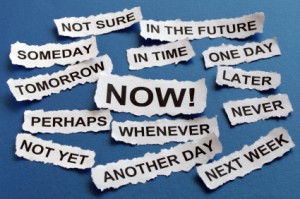
When not burning the midnight oil as the co-founder of www.WomenForTheWall.org, Leah Aharoni helps small businesses and organizations attract more clients and participants. Visit www.LoveYour.Biz for more of her tips and tools.
In his letters, the Lubavitcher Rebbe advised his emissaries that the dissemination of Torah has to be approached like a business. And no serious business starts off without a business plan.
Wait! Don’t browse away! I know what you are thinking. “Business plan? You mean like that 350-page grant request we did last year? It took us 3 months to get over the headache. No way!”
Whenever I mention business tools to entrepreneurs and non-profits, their eyes glaze over. They start thinking MBA and corporate speak. But nothing of the sort is needed.
The planning work I am talking about is quick and easy. It is called a 20-Minute Plan and all of it will be outlined for you. I promise. But first, why do you even need it?
A solid plan can make all the difference between success and failure in your work. Many an organization handle projects as they come up, routinely putting out fires. Before launching my present consulting company, I managed a translation agency for 10 years, with non-profits comprising 40% of my clientele. It never ceased to amaze me how some people always woke up on Rosh Chodesh Nissan to work on their Pesach programing and fundraisers, as if Pesach doesn’t roll around at a predictable time every year. They usually got their work done in time, but with a tremendous amount of stress and underwhelming results.

Many people refuse to plan, because in their experience, plans and reality don’t mix. Entrepreneurs like to joke that even the best conceived business plan doesn’t survive the collision with the first customer. Though reality may pan out very differently from what you have planned, doing the thinking work in advance will let you navigate the changes instead of being managed by them. It is the difference between taking a detour from the road on a well-planned trip and wandering aimlessly on an unfamiliar 6-lane highway without a GPS.
Devoting some time to thinking and planning can open your eyes to new possibilities, new programs, new target populations, and new resources. It can provide you with ideas for doing things smarter. And it can save you from possible obstacles and mistakes along the way.
Having a plan can help you stop procrastinating and start doing. Launching a new program or reaching out to new people is challenging. Changing your approach when the present one doesn’t really work is scary. Chazal teach us that all beginnings are difficult, not only because the early stages require an extra investment of effort. The hardest part is overcoming the internal fears of failure. “What will happen if I invest all this energy and things don’t work out?” we ask ourselves.
A roadmap that charts the territory and breaks the project into small chewable chunks makes it that much easier to put one foot ahead of the other and move towards creating the impact you want to create in your community.
Tachlis – The 20-Minute Plan
An organizational or project plan is not written in stone. It’s a work in progress and you don’t have to get it 100% right on the first go.
LeanStack has developed an easy and user-friendly visual tool to help you get all the information in one place. Start out by answering as many of the following questions as you can. You can always come back to add more detail or change things as you get additional insights.
Get input from rabbis, educators, colleagues, community members, and participants. They may have an angle you never considered. Some organizations make the planning work a community-wide project, so that the participants feel that they have a stake in the organization.
A good starter plan will help you understand:
- Your “clients” and their “problems” – More often than not you have several different “clienteles,” each with a unique mindset and needs. People come to your organization not because they want your programs, but because they want to solve their own problems. Unless you understand in depth and in detail why people turn to you, it will be hard to attract a following.
- What else is out there? – Chances are people in your community have other alternatives to your organization. Let’s say I am a mother of teens looking for a way to reinforce their Jewish identity. As far as I am concerned, the USY program at the local Conservative synagogue is as much of an option as the youth programing you are doing (and a lot less scary, too). You need to know exactly what you are up against to stand apart and provide the stuff that nobody else has.
- Why should they care? – Have you ever wondered why some people are willing to sleep outside an Apple store to be the first with iPhone 87893 in their hands, when they can get the same exact gadget two weeks later without waiting in line? Apparently, these people have bought into Apple’s image of technology pioneer. Having the latest Apple product fills a deep-seated need for recognition as the cool guy with the latest tech. It bestows bragging rights. Your organization needs an easy, compelling message that shows people that you get their needs and why they should care about what you do. Usually, it resonates with the things they believe to be important and satisfies emotional needs (stay tuned for more on that).
- Your solutions – Your programs have to be built around solving the clients’ problems. If you live in a community with marginally Jewish professionals, they aren’t likely to be interested in a daf yomi class. But there is a good chance they’ll come out to hear the Jewish perspective on hot-button business, medical, or legal issues that are part of their world. Knowing that Chazal had a far-reaching vision that is relevant today may interest them enough to come back for more.
- What makes you unique? – There are plenty of other schools/shuls/classes/events in town. Why should they come to yours? What do you give them that nobody else does?
- How will you reach them? – Once you know whom you are trying to reach, try to find some common denominators (age, demographics, interests, membership, who sells to them, etc.). Your job is to reach them fast, in large numbers, and without breaking the budget. This is the heart of your marketing. A good plan will provide for 3-4 different channels for reaching people. More on that here.
- How much will it cost? – This is the place to write down all the expenses (or guestimates) so you know how much the program will cost. You don’t want to be surprised when the bills pile in.
- What resources will you need? – The obvious first question is how to pay for the program. But beyond that, think about the resources that have to be in place for you to carry it out (space, staff/volunteers, materials, PR, etc). Many organizations rely on traditional fundraising from institutional and private donors or fundraising events. In a future post, we will explore ways to secure resources without paying for them, as well as getting programs to finance themselves.
- How will you measure success? – How many people would you like to take part in that class? How fast do you want that program up and running? What percentage of Jewish students on campus do you want to reach? Setting some goals and yardsticks to measure progress will let you evaluate your programs a few months or years later. It will give you the information you need to make changes or do more of the same.
Remember that you are not looking for perfection. And you won’t be judged by a foundation committee. A partial plan is better than none.
Use your browser’s print button to print out your plan and carry it around with you. Jot down your ideas. Show them to others. If you get stuck, feel free to reach out to me.
So what will you be planning with this tool?



















